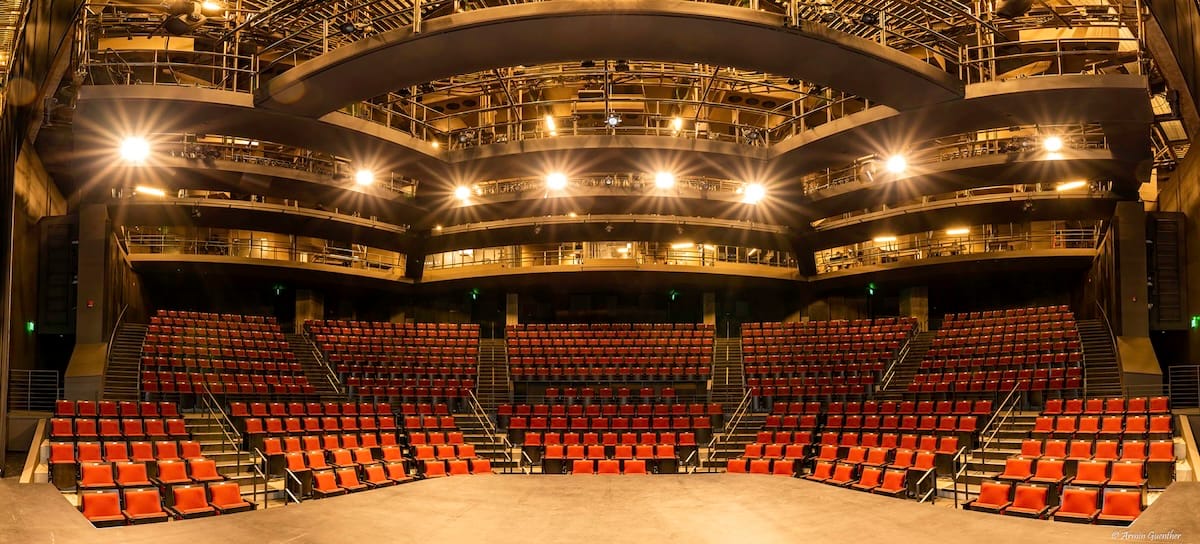Black box, proscenium, thrust – what’s the difference?

Theatre stages come in several distinct configurations, each creating a different relationship between performers and audience. Understanding these types can help you choose the best seats and know what to expect. Here are the main types you’ll encounter at Colorado theatres.
Proscenium Stage (from the Greek proskēnion, meaning “in front of the scene”) is the most traditional configuration, featuring a “picture frame” opening that separates the audience from the stage. The audience sits in rows facing the stage directly. Most large theatres use this setup, including the Denver Center’s Buell Theatre. This configuration works well for elaborate scenery and Broadway-style productions.
Other examples: Denver Curious Theatre, Breckenridge Backstage, Boulder Dairy Center Gordon Gamm Theatre
Thrust Stage extends into the audience area, with seating on three sides of the stage. This creates a more intimate connection between performers and audience. Actors can make entrances from the sides or back, and audience members get varied perspectives depending on where they sit.
Examples: Denver Center’s Wolf Theatre, Miners Alley Performing Arts Center in Golden, Thunder River Theatre Company in Carbondale
Theatre-in-the-Round: (also called arena staging) places the stage in the center with audience seating completely surrounding it on all sides. This is the most intimate configuration, creating a unique, immersive experience with typically no bad seats — though it can present challenges for scenery since sightlines must work from every angle.
Example: Denver Center Kilstrom Theatre

Black Box Theatre is a simple, flexible space with black walls and movable seating that can be arranged in various configurations. The stage can be set up as proscenium, thrust, in-the-round, or other creative arrangements depending on the production’s needs. These spaces are popular for experimental work and smaller productions.
Examples: Denver’s Buntport, Aurora Fox Studio Theatre, Arvada Center Black Box Theatre
Traverse Stage (less common) has audience seating on two opposite sides with the stage running between them, like a fashion runway. This creates interesting staging opportunities but is rarely used.
Example: Theatre Artibus has used this configuration in the flexible space of the Denver Savoy.
Dinner Theatre Configuration features table seating arranged cabaret-style or banquet-style throughout the audience area, rather than traditional theatre rows. The stage is typically proscenium or thrust, but the key difference is that patrons sit at tables where they’re served a meal before or during the performance.
This setup creates a more casual, social atmosphere compared to traditional theatre seating. The tables remain throughout the show, so sightlines can vary significantly depending on your table location — tables closer to the stage and more centered generally offer better views.
Examples: Candlelight Dinner Playhouse in Johnstown, Jester’s Dinner Theatre in Lafayette
Flexible Space is just what it sounds like — a space where the configuration can be changed to suit the show. Typically, this means a theatre without fixed seating, so chairs can be arranged in different ways. Often, a black box theatre is also a flex space.
Example: Silverthorne’s Theatre SilCo CVA Flex Theatre
The rake
Anyone who’s ever sat behind a person taller than themselves knows that how seats are arranged can make a big difference. How much the floor is sloped is known as the theatre’s “rake,” and it can vary dramatically between theatres.
On one end of the spectrum is a flat floor with no rake and, often, challenging sightlines. The other end is stadium style seating, where your seat is 12-15 inches above the one in front of you — almost guaranteeing you won’t be looking at the back of someone’s head. Perhaps the most generous rake in Colorado theatre is at the Dairy Center’s Gordon Gamm theatre.
While it may seem intuitive to have a steep enough rake to ensure those sightlines, other considerations like cost and safety come into play. Broadway.com has an extensive article on how to choose the best seats in a Broadway theatre, and many of the tips would apply to others as well. When purchasing tickets, ask about the theatre’s rake if you have concerns about sightlines, especially in smaller venues with flat floors.


Leave A Comment